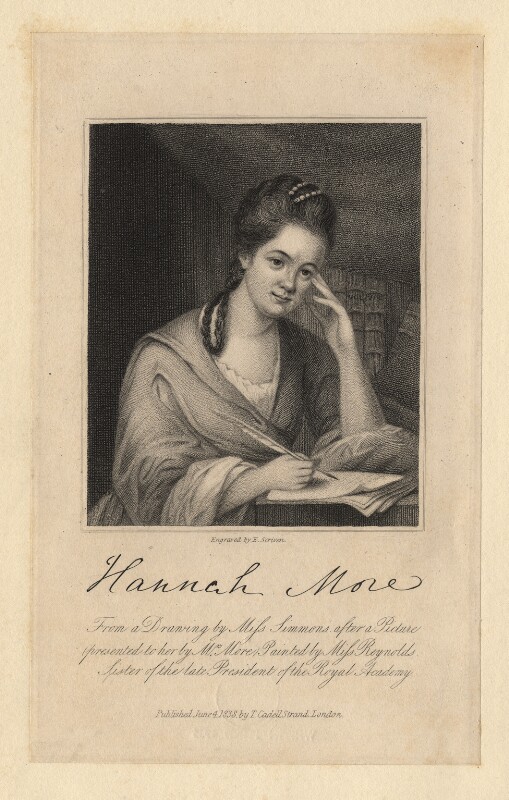Hannah More
(2 February 1745 - 7 September 1833)© National Portrait Gallery, London

Works in ECPA
alphabetical listing / listing in source editions
- THE BAS BLEU. ()
- FLORIO: A POETICAL TALE, FOR FINE GENTLEMEN AND FINE LADIES. ()
- SLAVERY, A POEM. ()
Source editions
- More, Hannah, 1745-1833. Florio: a tale: for fine gentlemen and fine ladies: and, the bas bleu; or, conversation: two poems. London: printed for T. Cadell, 1786. v,[3],89,[3]p. ; 4⁰. (ESTC T35621; OTA K037413.000)
- More, Hannah, 1745-1833. Slavery, a poem. By Hannah More. London: printed for T. Cadell, 1788. [4],20p. ; 4⁰. (ESTC T48439; OTA K045163.000)
Biographical note
Hannah More, the fourth of the five daughters of Jacob More (1700–1783), schoolmaster, and Mary, the daughter of John Grace, a farmer at nearby Stoke, was born at Fishponds, north of Bristol. The sisters supported themselves as teachers, and in 1758 the three eldest set up a boarding school in Bristol. More received a comprehensive education and subsequently began teaching at her father's school. She was engaged to William Turner of Belmont from about 1767, but after several postponements of the marriage, the engagement was dissolved and she received an annuity, which left her to some degree financially independent and enabled her to pursue her literary ambitions. She began publishing poems and wrote a play. She befriended the poet and critic John Langhorne and from 1774 the sisters began their annual visits to London. Here More met David and Eva Garrick, Elizabeth Montagu, and Joshua Reynolds, who in turn introduced her to Dr Johnson and Edmund Burke. She also forged lifelong friendships with Frances Boscawen, Elizabeth Carter, Hester Chapone, Elizabeth Vesey, and other members of the bluestocking circle. More commemorated their meetings in her poem The Bas Bleu, or, Conversation (1784), written in 1782. More helped to promote the work of fellow poet Ann Yearsley by setting up a subscription for her. After Garrick's death and under the influence of a number of eminent clergymen, including Robert Lowth, Josiah Tucker, George Horne, and Beilby Porteus, More's writing became increasingly pious and didactic. She spent less time in London and settled at Cowslip Green, Somerset, where she had built a cottage in 1784. She promoted Sunday Schools and became involved in the political struggle to abolish the slave trade. She met William Wilberforce in autumn 1787 and contributed to the campaign her poem Slavery, which she wrote in January 1788 to maximize publicity for Wilberforce's bill. She remained a loyal supporter of the cause for decades to come. In 1802, More and her sisters moved to Barley Wood near Wrington, where they entertained visitors including the new literary generation of Romantic poets. The last twenty years of More's life were dominated by ill health and loss. She nursed her sisters through successive illnesses and deaths, and in the 1820s succumbed to a series of serious illnesses, which left her confined to her room. She died at Clifton, aged eighty-eight, on 7 September 1833.
Bibliography
ODNB 19179; NCBEL 1598-1600; DLB 109; DMI 1940
Editions
-
Andrews, Kerri, ed. The Letters of Hannah More: A Digital Edition. University of Strathclyde, 2016. Web. 21 Jan. 2017. http://hannahmoreletters.co.uk/Letters/
Biography
-
Ford, Charles Howard. Hannah More: a critical biography. New York; Frankfurt; Bern; Paris: Lang, 1996. Print.
-
Jones, M. G. Hannah More. Cambridge: CUP, 1968. Print.
-
Prior, Karen Swallow. Fierce convictions: the extraordinary life of Hannah More: poet, reformer, Abolitionist. Nashville, TN: Nelson, 2014. Print.
-
Stott, Anne. Hannah More: the First Victorian. Oxford: Oxford University Press, 2003. Print.
Bibliography
-
Smith, Nicholas D. The Literary Manuscripts and Letters of Hannah More. Aldershot; Burlington, VT: Ashgate, 2008. Print.
Reference works
-
Baines, Paul, Julian Ferraro, Pat Rogers, eds. The Wiley-Blackwell Encyclopedia of Eighteenth-Century Writers and Writing, 1660-1789. Malden, MA: Wiley-Blackwell, 2011. 243-244. Print.
-
Radcliffe, David H., ed.
Hannah More (1745-1833)
. Spenser and the Tradition: ENGLISH POETRY 1579-1830. Center for Applied Technologies in the Humanities, Virginia Tech, 2006. Web. 14 Oct. 2011. https://web.archive.org/web/20170908014740/http://spenserians.cath.vt.edu/AuthorRecord.php?recordid=33214. -
Todd, Janet, ed. A Dictionary of British and American Women Writers 1660-1800. Paperback edition, revised. Lanham et al.: Rowman & Littlefield, 1987. 224-227. Print.
Criticism
-
Andrews, Kerri. Ann Yearsley and Hannah More, Patronage and Poetry: The Story of A Literary Relationship. London: Pickering & Chatto, 2013. Print.
-
Demers, Patricia.
'For Mine's a Stubborn and a Savage Will': 'Lactilla' (Ann Yearsley) and 'Stella' (Hannah More) Reconsidered
. Huntington Library Quarterly 56 (1993): 135-50. Print. -
Demers, Patricia. The world of Hannah More. Lexington: Kentucky UP, 1996. Print.
-
Haslett, Moyra.
Becoming Bluestockings: contextualising Hannah More's The Bas Bleu
. Journal for Eighteenth-Century Studies 33(1) (2010): 89-114. Print. -
Richardson, Alan.
Darkness visible: race and representation in Bristol Abolitionist poetry
. Wordsworth Circle 27(2) (1996): 67-72. Print. -
Waldron, Mary.
Mentors old and new: Samuel Johnson and Hannah More
. New Rambler D:11 (1995/96): 29-37. Print.
![[frontispiece]](/images/authors/colour-portraits/banner-frontispiece.jpg)
![[section of text]](/images/screenshots/ECPA-snippet5.jpg)
![[poet writing]](/images/authors/colour-portraits/banner-poet.jpg)